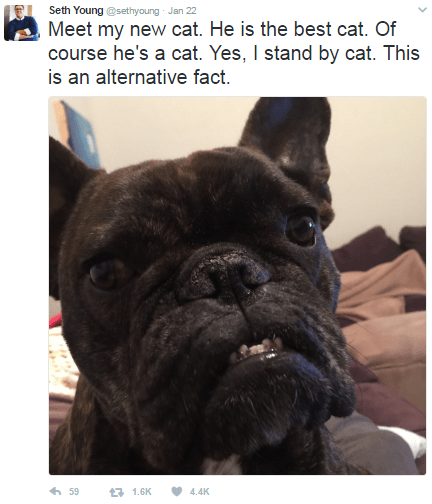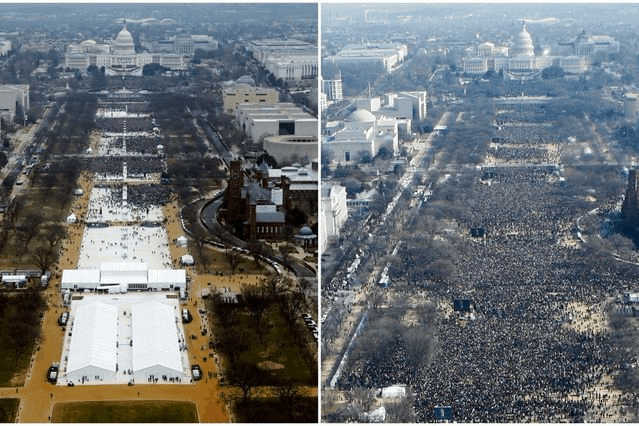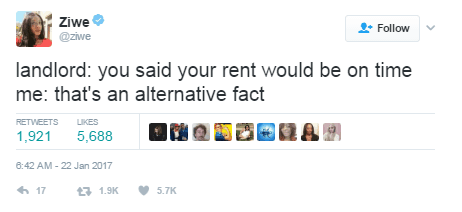Don’t be fooled by what you read online
Attendance at the presidential inauguration of Donald Trump became a hot topic after the president in question—and in denial—claimed that the crowd size “looked like a million, million and a half people”, although photographic evidence (left above) that depicted a thin crowd had proved otherwise.
This escalated with Sean Spicer’s debut briefing that was chock-full of inaccurate statements and statistics to decry such reports, which escalated with Kellyanne Conway’s unique interpretation of Spicer’s falsehoods as “alternative facts”, igniting a wildfire of mockery on Twitter that spawned plenty of hilarious ripostes:

Although it has been argued that the term “alternative facts” is an actual legal term to raise inconsistent facts or defences, The City Law School made it clear that “this does not mean that a party can state alternative facts that are within his knowledge, such that one or other must be a lie.”
That is to say Sean Spicer’s statements at his debut briefing—which had been debunked by the media for their misrepresentations—aren’t facts to begin with, and thus cannot even be identified as an alternative one. For all the controversy the public figure’s dishonesty has stirred, a foreboding development of the relationships among the media, the government, and its people lingers on the horizon and we should be worried.
So, why should we be worried?
The rise in the glossary of terms such as post-truth and fact-checking in a Trump era isn’t pure coincidence, and increasingly, the public’s dependence on authoritative sources for news is shifting as we become more aware of the fact that not everything we see or hear in print or online is a hundred percent true.
With the prevalence of social media, our sources of news are also pouring in from all directions, including peers, influencers, independent publishers and even satirical news outlet (often mixed with elements of fake news). The ability for anyone to spread information and influence at the tap of a finger has promoted the proliferation of fake news on the world wide web, and it’s getting harder to identify reliable communications from such an outpour.
Scaling it down, those of us residing in the Little Red Dot are also affected by our own moments of doubt. A most recent example points to Supermarket chain Fairprice, victim to a widely-circulated online rumour that claimed its house brand jasmine fragrant rice is made of plastic. In another hoax, the headline of a Straits Times Facebook post read “President (Tony) Tan invites Thailand’s new king to visit Singapore to eat KFC.”
Contemporary Singapore has yet to come across a hoax so far-reaching in consequences that it has disrupted our well-preserved peace and harmony on a national level—but, it could happen. So here are five ways in which you can keep savvy and tap on self-reliance to filter out the phonies:
1. Check The URL
Don’t let a professional-looking site fool you into thinking it’s legitimate. These days, with the existence of user-friendly website builders, fake news website can easily be disguised.
To tell them apart, check the URL. If you are staring at one that ends in .co or .su as opposed to the usual .com, .org or .net, it is likely that you have entered phony territory as established news organisations own credible domains.
2. Don’t Fall For Clickbait Titles
Cinnamon roll can explodes inside man’s butt during shoplifting incident! Woman arrested for defecating on boss’ desk after winning the lottery! More often than not, hyperbole is a telling sign of a fake story and serves no other purpose than clickbaits—if it’s too preposterous to be true, it likely isn’t true.
3. Down The Comment Thread
Ah, the paradox of social media. On one hand, it amplifies the circulation of fake news and stories, but on the other, it allows the general community to denounce any faux reporting.
Take some time to scroll through the comment thread of a story of suspicious credibility and you will be able to make a confident conjecture.
4. Fact Check
Sometimes, a quick internet search can easily eliminate a misinformation. Are other publications reporting on the same topic? Did a major publication call out the hoax?
If a story is only reported by a single source and makes no credible references, its integrity should be called into question.
5. Data & Statistics Need Context
We may accept colourful representations of data or quantifiable statistics unquestionably because they are facts, but facts can still be grossly misrepresented when taken out of context.
According to Daniel Levitin, author of A Field Guide To Lies And Statistics, fiddling with axes on the scale of chart can make “a small change looks like a giant leap”. Therefore, the responsibility still lies with us to ensure that we don’t just soak up information blindly, but to sift them with thoughtful cognizance.



















